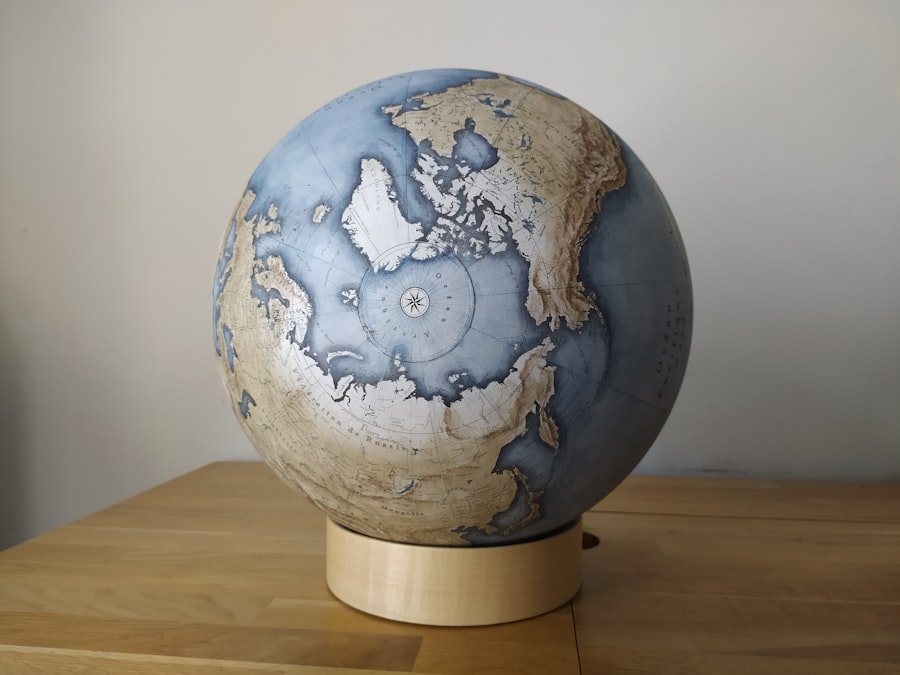The geodynamo is a fascinating and complex phenomenon that plays a crucial role in shaping the Earth as we know it. At its core, the geodynamo refers to the process by which the Earth’s magnetic field is generated and maintained. This magnetic field is not merely a byproduct of the planet’s structure; it is a dynamic system that arises from the movement of molten iron and nickel in the outer core.
The geodynamo is responsible for creating a protective shield around the Earth, which has significant implications for life on the planet. Understanding this intricate mechanism is essential for grasping how Earth functions and how it has evolved over geological time. The significance of the geodynamo extends beyond its role in generating the magnetic field.
It influences various geological and atmospheric processes, making it a subject of great interest to scientists across multiple disciplines. From geophysicists to climatologists, researchers are keen to unravel the mysteries of the geodynamo, as it holds keys to understanding not only Earth’s past but also its future. As humanity continues to explore the cosmos, the geodynamo serves as a reminder of the unique conditions that make Earth a habitable planet.
Key Takeaways
- The geodynamo is the mechanism responsible for generating Earth’s magnetic field.
- Understanding the Earth’s magnetic field is crucial for protecting the planet from harmful solar radiation.
- The geodynamo plays a vital role in shielding Earth from solar winds and cosmic rays.
- Historical discoveries and research have contributed to our understanding of the inner workings of the geodynamo.
- The geodynamo has a significant impact on climate, weather, and human technology.
Understanding Earth’s Magnetic Field
Earth’s magnetic field is an invisible force that envelops the planet, extending far into space and forming what is known as the magnetosphere. This field is generated by the geodynamo process, which involves the movement of conductive fluids in the outer core. The magnetic field is not uniform; it varies in strength and direction at different locations and altitudes.
The field lines emerge from the Earth’s surface near the magnetic poles and curve back into the Earth at the equator, creating a complex pattern that influences various natural phenomena. The magnetic field serves several critical functions. It protects the Earth from solar wind—streams of charged particles emitted by the sun—which can strip away the atmosphere and expose the surface to harmful radiation.
Additionally, it plays a vital role in navigation for both humans and animals. Compasses rely on Earth’s magnetic field to point toward magnetic north, guiding explorers and travelers for centuries. Understanding how this magnetic field operates is essential for comprehending its broader implications for life on Earth.
The Role of the Geodynamo in Protecting Earth

The protective capabilities of the geodynamo are one of its most vital functions. By generating Earth’s magnetic field, the geodynamo acts as a shield against cosmic radiation and solar wind. Without this magnetic barrier, charged particles from the sun would bombard the Earth’s atmosphere, leading to severe consequences for life on the planet.
The interaction between solar wind and Earth’s magnetic field creates phenomena such as auroras, which are not only beautiful but also indicative of the protective role played by the geodynamo. Moreover, the geodynamo contributes to maintaining a stable atmosphere. The magnetic field helps prevent atmospheric erosion caused by solar radiation, allowing Earth to retain essential gases like oxygen and nitrogen.
This stability is crucial for sustaining life, as it creates an environment where biological processes can thrive. The geodynamo’s protective influence underscores its importance in maintaining conditions conducive to life on Earth.
The Inner Workings of the Geodynamo
| Metrics | Data |
|---|---|
| Geodynamo Strength | 25 – 65 microteslas |
| Geodynamo Speed | 10 – 40 kilometers per year |
| Geodynamo Components | Outer core, inner core, mantle |
| Geodynamo Mechanism | Thermal convection, compositional convection |
The geodynamo operates through a combination of physical processes involving heat transfer, fluid dynamics, and electromagnetic interactions.
As these conductive fluids move, they generate electric currents, which in turn produce magnetic fields.
This self-sustaining process creates a feedback loop that maintains Earth’s magnetic field over geological timescales. The complexity of the geodynamo is further enhanced by factors such as rotation and turbulence within the outer core. The Coriolis effect, resulting from Earth’s rotation, influences fluid motion and contributes to the organization of magnetic field lines.
Additionally, variations in temperature and composition within the outer core lead to fluctuations in magnetic intensity and direction. These dynamic processes make studying the geodynamo a challenging yet rewarding endeavor for scientists seeking to understand its intricacies.
Historical Discoveries and Research on the Geodynamo
The study of the geodynamo has evolved significantly over time, with early theories dating back to the 19th century. Pioneering scientists such as Michael Faraday and James Clerk Maxwell laid foundational principles in electromagnetism that would later inform our understanding of Earth’s magnetic field. However, it was not until the mid-20th century that researchers began to develop comprehensive models of the geodynamo process itself.
Advancements in technology have played a crucial role in enhancing our understanding of the geodynamo. The advent of computer simulations has allowed scientists to model complex fluid dynamics and electromagnetic interactions within the outer core. These simulations have provided valuable insights into how changes in temperature, pressure, and composition can influence magnetic field behavior over time.
Ongoing research continues to refine these models, shedding light on historical geomagnetic reversals and their implications for Earth’s geological history.
The Connection Between the Geodynamo and Plate Tectonics

The geodynamo is intricately linked to plate tectonics, another fundamental aspect of Earth’s geology. The movement of tectonic plates is driven by convection currents in the mantle, which are influenced by heat generated from radioactive decay and residual heat from Earth’s formation. This heat transfer not only drives plate movements but also affects fluid dynamics within the outer core, thereby impacting the geodynamo process.
Conversely, changes in Earth’s magnetic field can provide insights into tectonic activity. For instance, paleomagnetic studies—analyzing ancient rocks for their magnetic orientation—have revealed patterns of plate movement over millions of years. These studies have shown that periods of geomagnetic reversal often coincide with significant tectonic events, suggesting a complex interplay between these two geological processes.
Understanding this connection enhances our comprehension of Earth’s dynamic systems and their interdependencies.
The Impact of the Geodynamo on Climate and Weather
The influence of the geodynamo extends beyond geology into atmospheric science, where it plays a role in climate and weather patterns. The magnetic field affects solar radiation reaching Earth’s surface, which can influence temperature distributions and atmospheric circulation patterns. Variations in solar activity can lead to changes in geomagnetic activity, which may have downstream effects on weather systems.
Moreover, understanding how solar wind interacts with Earth’s magnetic field can provide insights into space weather phenomena that impact satellite operations and communication systems on Earth. For instance, geomagnetic storms caused by solar flares can disrupt electrical grids and satellite communications, highlighting how interconnected these systems are with Earth’s magnetic environment. As climate change continues to be a pressing global issue, understanding these interactions becomes increasingly important for predicting future climate scenarios.
Challenges and Mysteries in Studying the Geodynamo
Despite significant advancements in understanding the geodynamo, many challenges remain in studying this complex system. One major hurdle is accessing direct observations from within Earth’s outer core, as it lies beneath thousands of kilometers of solid rock. Consequently, much of what scientists know about the geodynamo comes from indirect measurements and computer simulations.
Additionally, there are still many unanswered questions regarding how changes in Earth’s magnetic field may influence geological processes or how external factors like solar activity can affect geomagnetic behavior. Researchers continue to grapple with these mysteries while developing new technologies and methodologies to enhance their understanding of this intricate system. As they delve deeper into these challenges, they hope to uncover new insights that could reshape our understanding of Earth’s dynamics.
The Geodynamo and its Influence on Human Technology
The implications of the geodynamo extend into human technology in various ways. For instance, navigation systems rely heavily on Earth’s magnetic field for accurate positioning. Compasses have been used for centuries as navigational tools, guiding explorers across uncharted territories.
In modern times, GPS technology also takes into account geomagnetic variations to enhance accuracy.
Satellites are particularly vulnerable to these storms; therefore, monitoring geomagnetic activity helps mitigate risks associated with satellite communications and power grids on Earth.
As society becomes increasingly reliant on technology, comprehending how the geodynamo influences these systems will be essential for ensuring their resilience against natural phenomena.
The Future of Geodynamo Research and Exploration
Looking ahead, research on the geodynamo promises to yield exciting discoveries that could reshape our understanding of Earth’s processes. Advances in computational modeling techniques will likely enhance scientists’ ability to simulate complex interactions within the outer core more accurately than ever before. Additionally, interdisciplinary collaborations between geophysicists, climatologists, and engineers may lead to innovative approaches for studying this intricate system.
Future exploration may also involve developing new technologies capable of probing deeper into Earth’s interior or utilizing satellite missions designed specifically to monitor geomagnetic activity from space. As researchers continue to push boundaries in their quest for knowledge about the geodynamo, they will undoubtedly uncover new insights that deepen humanity’s understanding of our planet’s dynamic systems.
The Importance of Earth’s Invisible Shield
In conclusion, the geodynamo represents one of Earth’s most vital yet often overlooked systems—a dynamic process that generates a protective magnetic field essential for sustaining life on our planet. Its influence extends across various scientific disciplines, from geology to atmospheric science and technology. As researchers continue to unravel its complexities, they gain valuable insights into not only Earth’s past but also its future.
Understanding the geodynamo is crucial for appreciating how interconnected Earth’s systems are and how they impact life as we know it. As humanity faces challenges such as climate change and technological vulnerabilities, recognizing the importance of this invisible shield becomes increasingly relevant. The ongoing exploration of the geodynamo will undoubtedly yield discoveries that enhance our understanding of Earth’s intricate workings while reinforcing its significance as a haven for life amidst an ever-changing universe.
The geodynamo is a fascinating process responsible for generating Earth’s magnetic field, driven by the movement of molten iron within the planet’s outer core. For those interested in exploring more about the intricacies of Earth’s magnetic phenomena, a related article can be found on XFileFindings. This article delves into the scientific principles and recent discoveries surrounding the geodynamo. To read more, visit the article by clicking on this link.
WATCH NOW! Leaked Pentagon Map Reveals True Pole Shift Disaster, and Hidden Survival Zones
FAQs
What is the geodynamo?
The geodynamo is the mechanism responsible for generating Earth’s magnetic field. It is driven by the movement of molten iron and nickel in the outer core of the Earth.
How does the geodynamo work?
The geodynamo works through the process of convection, where heat from the Earth’s core causes the molten iron and nickel to move, generating electric currents and ultimately producing the magnetic field.
Why is the geodynamo important?
The geodynamo is important because it creates Earth’s magnetic field, which protects the planet from harmful solar radiation and cosmic rays. It also plays a crucial role in the formation of the Earth’s geology and climate.
What are the implications of changes in the geodynamo?
Changes in the geodynamo can have significant implications for Earth’s magnetic field, including potential weakening or reversal of the field. This could impact navigation systems, animal migration patterns, and the protection of the atmosphere from solar radiation.
How do scientists study the geodynamo?
Scientists study the geodynamo through a combination of laboratory experiments, computer simulations, and observations of Earth’s magnetic field. They also analyze ancient rocks and minerals to understand the history of the magnetic field.
